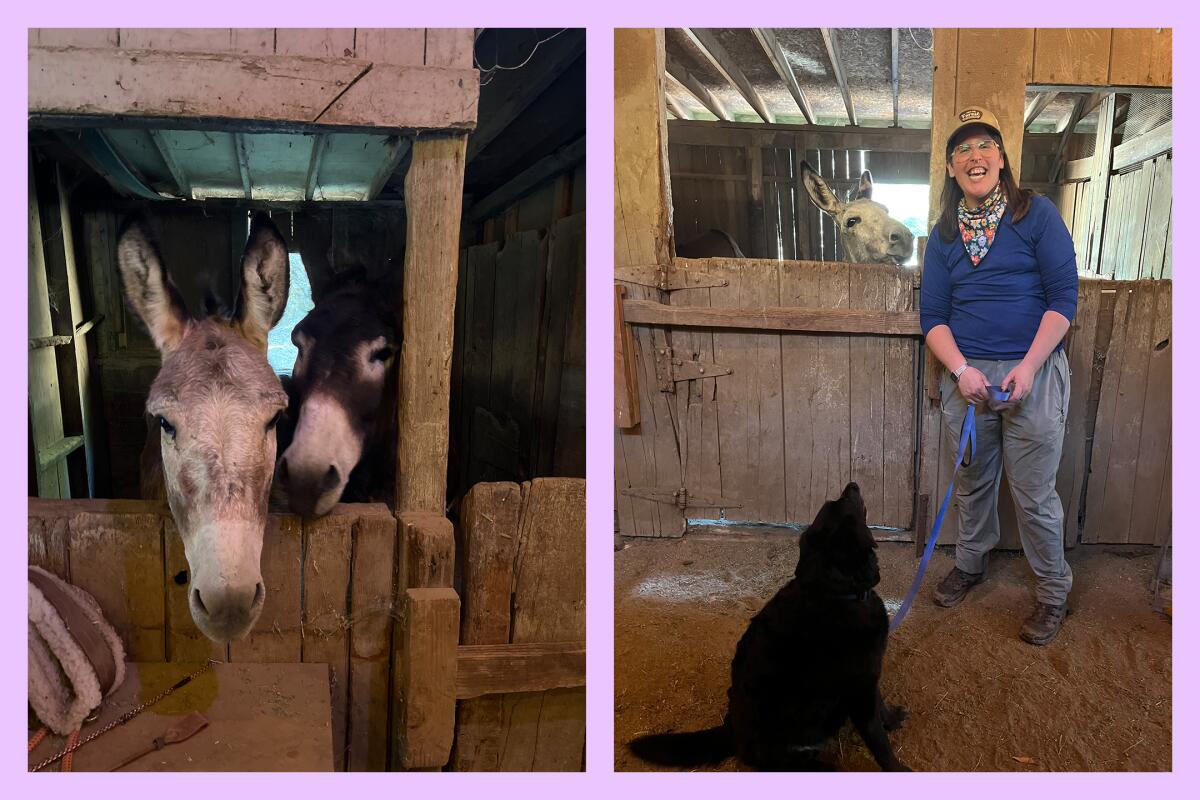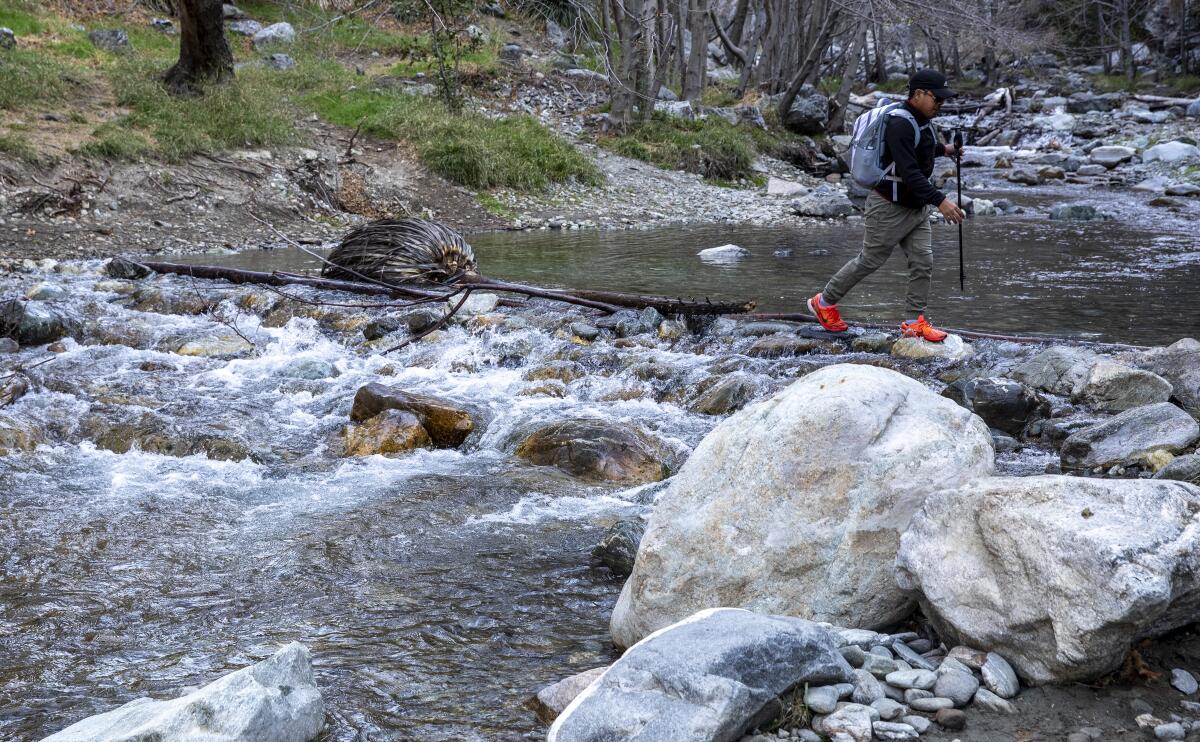Four years after the Bobcat fire and subsequent floods tore through Angeles National Forest, the pristine mountain wonderland of Big Santa Anita Canyon near Sierra Madre reopened to the public Wednesday.
You can once again hike to 55-foot Sturtevant Falls, one of the highest waterfalls in Angeles National Forest, and visit Sturtevant Camp, including its historic lodge, which will be open Saturdays and Sundays. The hike to the falls starts at the Chantry Flat parking lot and is about 3.6 miles in and back. You can take a similar route just over 4 miles to Sturtevant Camp, where eventually cabins will be available to rent.

Sturtevant Falls is a 55-foot waterfall in Angeles National Forest. At right, a water crossing on the way to Sturtevant Falls in Big Santa Anita Canyon.
(Jaclyn Cosgrove / Los Angeles Times)
Along either route, you’ll see and hear the rush of water over multiple small dams. The trail is also home to some particularly noisy acorn woodpeckers who’ve perhaps grown accustomed to a few visitors.
Other trails reopening include lower Winter Creek to Hoegees Trail Camp, a 2.2-mile(ish) route that follows Winter Creek, which is currently running. The upper Winter Creek trail has also reopened, which you can take to the Mount Wilson Toll Road to reach Mt. Wilson. It’s a challenging forested hike that’s about 14 miles. (As of Wednesday, the Forest Service hadn’t released an updated map of the area, hence estimates in distances).
The Chantry Flat picnic area, which has flush toilets and sinks, has also been restored and includes a wheelchair-accessible ramp leading to picnic tables.
Newsletter
You are reading The Wild newsletter
Sign up to get expert tips on the best of Southern California’s beaches, trails, parks, deserts, forests and mountains in your inbox every Thursday
You may occasionally receive promotional content from the Los Angeles Times.
The charming Adams Pack Station will reopen to the public and host pop-up food vendors until it can fully reopen its kitchen. Consider visiting for its upcoming Dia De Los Muertos fundraiser on Nov. 1, where there will be a mariachi band and an opportunity to hang out with the pack station’s nine donkeys. (Proceeds benefit the pack station.)
Hoegees Trail Camp, a hike-in trail camp, will reopen but without a restroom, as it was removed after the Bobcat fire.
Sturtevant Trail, a 2.6-mile trail that starts near Sturtevant Camp and ends near Mt. Wilson, is closed.
And, unfortunately Zion Trail, a 2.5-mile trek popular among hikers and mountain bikers, is “completely wiped out,” says Estephany Campos, acting recreation officer of the Los Angeles Gateway Ranger District of the Angeles National Forest.

Two donkeys who live at the Adams Pack Station are seen at left. At right, Wild newsletter writer Jaclyn Cosgrove and their dog visit one of the donkeys, Willow.
(Jaclyn Cosgrove / Los Angeles Times)
“If you walked next to where it starts, you wouldn’t even be able to tell that it was once there,” Campos said. “But we do have a group of volunteers and staff members that, [because] that is a beloved trail, they do want to work on it while we’re open.”
Before the fire, hikers often started the Gabrielino National Recreation Trail, a 28.8-mile backpacking route through Angeles National Forest, at Chantry Flat. However, currently you can hike only about four miles from its trailhead at Chantry Flat to Sturtevant Camp. The next two-mile stretch from Sturtevant Camp northeast to Newcomb Pass remains impassable. The Spruce Grove Campground, which sits just before Sturtevant Camp, is one of several trail camps along the Gabrielino Trail and has reopened to visitors. Also, great news: It has a restroom.
Most important to note: The popular waterfall Hermit Falls is unreachable.

Chantry Flat Picnic Area features picnic tables and, when allowed, grills. Currently the fire risk is too high for anything with a flame.
(Jaclyn Cosgrove / Los Angeles Times)
“It is beautiful — and you can’t get there anymore because the trail is completely wiped out,” said Kellie Torio of Sierra Madre Search and Rescue. “If you slip and fall, you’ll be slipping on soft sand and dirt, and you’re going to canyon bottom.”
Before the Bobcat fire, the most common reason Sierra Madre Search and Rescue went to Big Santa Anita Canyon was to retrieve injured cliff jumpers who leaped from Hermit Falls. Torio said that now that Hermit Falls is unreachable, her rescue team fears it will be called to the site to save hikers who did not heed their warnings.
“Please don’t try,” she said.
Lingering closures aside, Big Santa Anita Canyon has come a long way since the Bobcat fire started in early September of 2020, igniting near the Cogswell Dam and burning almost 116,000 acres. It was one of the largest fires in modern L.A. County history.

A water crossing on a trail through Big Santa Anita Canyon, left. Be careful as you balance on this board at right over a water crossing on the way to Sturtevant Falls. A certain newsletter writer almost fell off.
(Jaclyn Cosgrove / Los Angeles Times)
Ambling through the canyon, I felt a tremendous sense of gratitude toward the trail crews who spent the last four years rebuilding the trails in this area.
Eric Mulfinger, with Restoration Legacy Crew, said that a few months after the fire, the area looked like a “moonscape,” burned beyond recognition.
He and his group — along with San Gabriel Mountain Trailbuilders and Lowelifes Respectable Citizens’ Club — spent hundreds of hours mostly without power tools to restore the trails.
I asked, Mulfinger, a retired high school math teacher, whether he ever found working on these trails demoralizing, given that another wildfire or storm could erase them in a flash.
Mulfinger said his group has a catchphrase that underscores that they’ve accepted their impact is temporary: “Nature bats last.”
“Part of my thinking is, you make the trails easy to walk on, get people back there so they can appreciate it, and actually get a little closer to nature and see what’s going on, [and that gives] a constituency for preservation for these spaces,” he said. “If no one goes back there, then no one will care what happens to it. But if people go back and enjoy it, then they will care.”
And, as every fire season teaches us, we have to appreciate what we have while we have it.

3 things to do

A fish-eating bat, myotis vivesi, found on Isla Partida Norte in Mexico.
(Scott Trageser / NatureStills Photography)
1. Learn about the world’s only pescatarian bat species in San Pedro
There are more than 1,400 species of bats worldwide, but only one has been discovered to hunt for fish in the ocean. You can learn about the feeding habits of the myotis vivesi at a free lecture at 7 p.m. Friday at the Cabrillo Marine Aquarium (3720 Stephen M. White Drive) in San Pedro. Scientist Brad R. Blood will give a presentation on the natural history of the species and how this marine bat — which lives on islands in the Gulf of California, coastal Sonora and the Pacific coast of Baja California — has adapted to eating fish and shrimp (but no hush puppies). Tickets are available at eventbrite.com.
2. Contribute to science in Elephant Hill
Help document local flora and fauna from 9 a.m. to noon Saturday at Elephant Hill, a 110-acre open space in northeast L.A. Local groups, including Coyotl + Macehualli, Save Elephant Hill, Anawakalmekak, Test Plot and North East Trees, will be on hand to guide the hunt — as will research scientists from the Natural History Museum of L.A. County, who will join the group on the walk through the area. The group will start near 4403 N. Randolph Ave., and members will use phone app iNaturalist to take photos of native plants and animals for the habitat survey. Participants are advised to bring a hat, sunscreen, water bottle and comfortable clothing and shoes. Some parts of the walk will be in the sun and require navigating over rocky, rutted terrain, sometimes over loose dirt. All ages welcome. Register at eventbrite.com.
3. Water oak trees in Topanga
The Resource Conservation District of the Santa Monica Mountains is hosting a volunteer event from 9 a.m. to noon Saturday at Trippet Ranch in Topanga State Park. Volunteers will help care for more than 400 oak trees in the area, watering, weeding and mulching trees as well as possibly planting acorns to replace trees that have died. Volunteers will also help gather data for a reforestation project the group has been working on since 2018. Dress in clothing you don’t mind getting dirty, and wear sturdy shoes. Organizers also ask that you bring a sun hat, layers and drinking water. The group will meet in the parking lot of Trippet Ranch (20829 Entrada Road in Topanga). Parking is limited. Register at eventbrite.com.

The must-read

Besman Ginping balances on logs and rocks as he crosses the east fork of the San Gabriel River, part of the Bridge to Nowhere trail, now closed due to a recent fire.
(Brian van der Brug / Los Angeles Times)
The Bridge, Line and Airport fires started in early September and burned through several natural areas cherished for their beauty, solitude and native plants and wildlife. Last week, I had the painful assignment of analyzing which trails were burned, closed or both in Angeles, San Bernardino and Cleveland national forests as a result of these three fires. More than 100 trails across Southern California are closed, including popular treks in our backyard like the Bridge to Nowhere hike, near where the Bridge fire started. Multiple trails to Mt. Baldy and the popular Mt. Baden-Powell hike near Wrightwood are closed because of their proximity to the Bridge fire scar. The three fires are mostly contained, but it remains unclear when these areas will reopen.
Until then, I’m going to focus on exploring more of the desert in the winter and checking out peaks open on the western side of Angeles National Forest I’ve yet to summit.
Happy adventuring,

P.S.
Want to win tickets for the Palm Springs Aerial Tramway? Send via postcard your guess for the correct date of first measurable snowfall at the tramway’s Mountain Station, elevation 8,516 feet, to the address listed here, and you might just win.
For more insider tips on Southern California’s beaches, trails and parks, check out past editions of The Wild. And to view this newsletter in your browser, click here.
